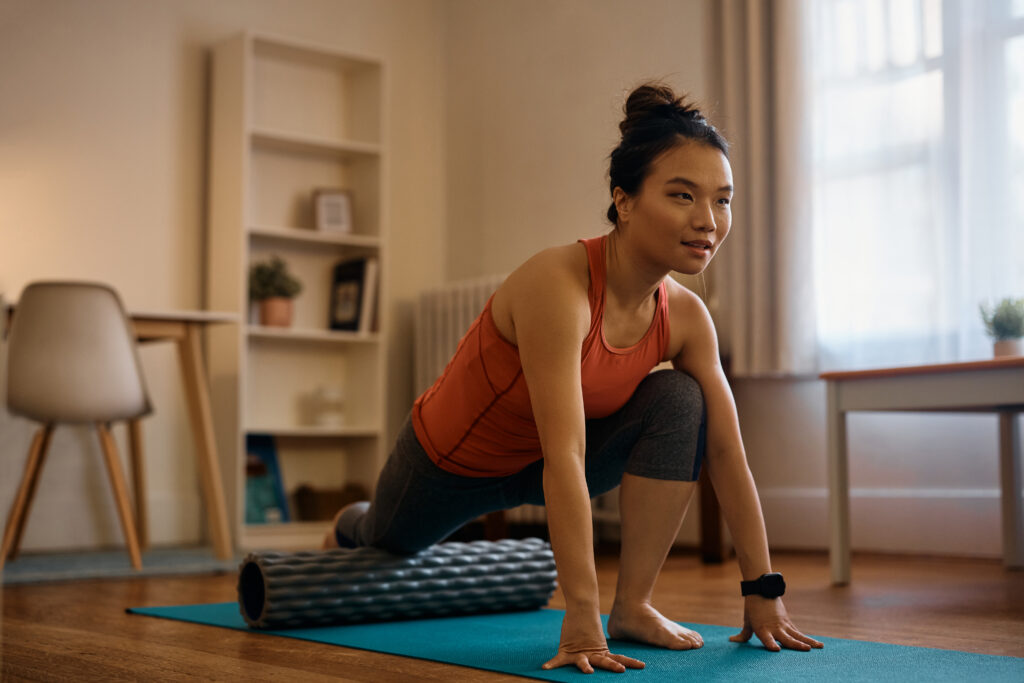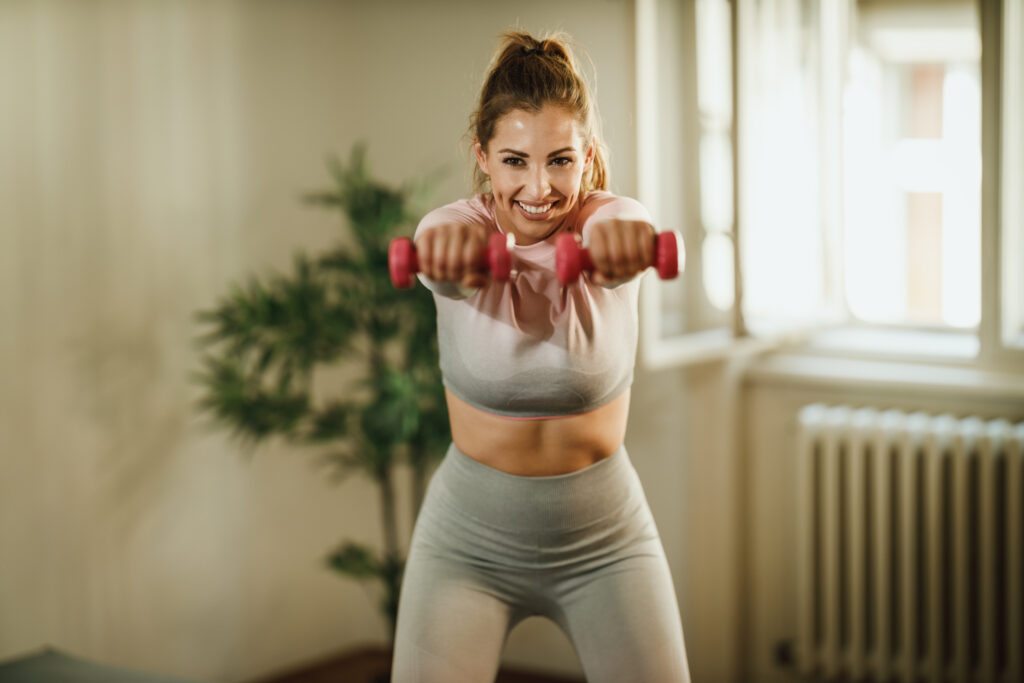Are you looking for effective cardio exercises that you can do in the comfort of your own home? Whether you’re a beginner or just prefer working out at home, incorporating cardio into your fitness routine is essential for improving cardiovascular health, burning calories, and boosting your overall fitness. In this comprehensive guide, we’ve compiled 20 home cardio routines specifically designed for beginners. These exercises require minimal equipment and can be easily modified to suit your fitness level. Let’s dive in and discover the best cardio exercises you can do at home.

Table of Contents – 20 Home Cardio Routines for Beginners
- Why Cardio is Important
- Benefits of Home Workouts
- Getting Started: Warm Up
- Beginner Cardio Exercises
- Intermediate Cardio Exercises
- Advanced Cardio Exercises
- Cardio Circuit Workout
- Tips for Getting the Most Out of Home Workouts
- Safety Precautions
- Summary
1. Why Cardio is Important
Cardiovascular exercises, also known as cardio, are any activities that increase your heart rate and improve your cardiovascular fitness. Engaging in regular cardio workouts has numerous benefits for your overall health and well-being. Some of the key advantages of incorporating cardio into your fitness routine include:
- Improved Heart Health: Cardiovascular exercises strengthen your heart, making it more efficient at pumping blood and oxygen throughout your body.
- Weight Loss and Management: Regular cardio workouts help burn calories, making it an effective tool for weight loss and weight management.
- Increased Stamina and Endurance: Cardio exercises improve your lung capacity and oxygen consumption, enhancing your stamina and endurance.
- Reduced Risk of Chronic Diseases: Engaging in regular cardio workouts can lower the risk of chronic diseases such as heart disease, diabetes, and certain types of cancer.
- Stress Relief: Cardio exercises release endorphins, which are known as “feel-good” hormones, helping to reduce stress and improve your mood.
- Enhanced Mental Health: Regular cardio workouts have been shown to reduce symptoms of depression and anxiety and improve overall mental well-being.
2. Benefits of Home Workouts
Working out at home offers several advantages, especially for beginners. Here are some of the benefits of home workouts:
- Convenience: You can exercise at any time that suits your schedule, without the need to travel to a gym or fitness center.
- Privacy: Working out at home provides a more private environment, allowing you to feel more comfortable and confident during your workouts.
- Cost-Effective: Home workouts eliminate the need for expensive gym memberships, saving you money in the long run.
- Flexible Routine: You have the freedom to design your own workout routine and choose exercises that align with your goals and preferences.
- No Equipment Required: Many cardio exercises can be performed using only your body weight, eliminating the need for specialized equipment.
- Minimal Space: Home workouts can be done in small spaces, making it accessible for those with limited room to exercise.
- Family-Friendly: Working out at home allows you to involve your family members, making it a fun and healthy activity for everyone.

3. Getting Started: Warm Up
Before diving into your home cardio workout, it’s crucial to warm up your muscles and prepare your body for exercise. A proper warm-up routine can help prevent injuries and improve your performance during the workout. Here’s a simple warm-up routine to get you started:
- March in Place: Start by marching in place, lifting your knees high and swinging your arms. Continue for 1-2 minutes.
- Arm Circles: Stand with your feet shoulder-width apart and extend your arms out to the sides. Make small circles with your arms, gradually increasing the size of the circles. After 10 seconds, reverse the direction of the circles. Repeat for 1 minute.
- Torso Twists: Stand with your feet hip-width apart and place your hands on your hips. Twist your torso to the right, then to the left, without moving your lower body. Repeat for 1 minute.
- Hip Circles: Stand with your feet shoulder-width apart and place your hands on your hips. Circle your hips clockwise for 30 seconds, then switch to counterclockwise for another 30 seconds.
- Leg Swings: Hold onto a stable surface, such as a wall or chair, for support. Swing one leg forward and backward, then switch to the other leg. Repeat for 1 minute.
- Ankle Circles: Sit on the edge of a chair and extend one leg in front of you. Rotate your ankle clockwise, then counterclockwise. Switch to the other leg and repeat. Perform ankle circles for 30 seconds on each leg.

4. Beginner Cardio Exercises
If you’re new to cardio exercises or have limited fitness experience, these beginner-friendly exercises are a great place to start. They require minimal equipment and can be modified to suit your fitness level.
Jumping Jacks
How to do it:
- Stand with your feet together and your arms by your sides.
- Jump up, spreading your feet wider than hip-width apart, and simultaneously raise your arms above your head.
- Quickly jump back to the starting position, bringing your feet together and lowering your arms.
- Repeat for the desired number of repetitions.
Muscles worked: Jumping jacks target the cardiovascular system, as well as the muscles in your legs, hips, and shoulders.
March in Place
How to do it:
- Stand with your feet hip-width apart and your arms by your sides.
- Lift your right knee as high as comfortable while swinging your left arm forward.
- Lower your right leg and repeat the movement with your left knee and right arm.
- Continue alternating knees and arms for the desired number of repetitions.
Muscles worked: Marching in place activates the muscles in your lower body, including your quadriceps, hamstrings, and calves.
High Knees
How to do it:
- Stand with your feet hip-width apart and your arms by your sides.
- Lift your right knee as high as possible, bringing it towards your chest, while swinging your left arm forward.
- Lower your right leg and repeat the movement with your left knee and right arm.
- Continue alternating knees and arms at a fast pace, as if you’re running in place.
Muscles worked: High knees engage your lower body muscles, including your quadriceps, hamstrings, and calves, while also increasing your heart rate.
Butt Kicks
How to do it:
- Stand with your feet hip-width apart and your arms by your sides.
- Bend your right knee and kick your right heel towards your glutes, while swinging your left arm forward.
- Lower your right leg and repeat the movement with your left leg and right arm.
- Continue alternating legs and arms at a fast pace, as if you’re jogging in place.
Muscles worked: Butt kicks target your hamstrings, quadriceps, and calves, while also providing a cardiovascular challenge.
Jumping Rope
How to do it:
- Hold the handles of a jump rope, with your hands slightly wider than shoulder-width apart.
- Swing the rope over your head and jump over it with both feet, landing softly on the balls of your feet.
- Continue jumping over the rope, maintaining a steady rhythm.
Muscles worked: Jumping rope is a full-body exercise that targets your legs, glutes, core, and shoulders, while also improving coordination and cardiovascular fitness.
5. Intermediate Cardio Exercises
Once you’ve mastered the beginner cardio exercises, you can progress to more challenging intermediate movements. These exercises will further elevate your heart rate and help you build endurance.
Mountain Climbers
How to do it:
- Start in a high plank position with your hands directly under your shoulders and your body in a straight line.
- Draw your right knee towards your chest, then quickly switch legs, bringing your left knee towards your chest while extending your right leg back.
- Continue alternating legs as if you’re running in a plank position.
Muscles worked: Mountain climbers engage your core, shoulders, and legs while providing a cardiovascular challenge.
Burpees
How to do it:
- Stand with your feet hip-width apart and your arms by your sides.
- Lower into a squat position, placing your hands on the floor in front of you.
- Jump your feet back, landing in a high plank position.
- Perform a push-up by lowering your chest towards the floor, then pushing back up.
- Jump your feet forward, returning to the squat position.
- Explosively jump up, reaching your arms overhead.
Muscles worked: Burpees target multiple muscle groups, including your chest, shoulders, triceps, core, glutes, and legs, while also providing a cardiovascular challenge.
Jump Squats
How to do it:
- Stand with your feet slightly wider than shoulder-width apart and your toes pointed slightly outward.
- Lower into a squat position, keeping your chest lifted and your knees tracking over your toes.
- Explosively jump up, reaching your arms overhead, and extending your hips and knees.
- Land softly and immediately lower back into the squat position to complete one repetition.
Muscles worked: Jump squats primarily target your quadriceps, hamstrings, glutes, and calves, while also engaging your core and cardiovascular system.
Lunges
How to do it:
- Stand with your feet hip-width apart and your hands on your hips.
- Step forward with your right foot, lowering your body until your right knee forms a 90-degree angle.
- Push through your right heel to return to the starting position.
- Repeat the movement with your left leg, alternating legs for the desired number of repetitions.
Muscles worked: Lunges primarily target your quadriceps, hamstrings, glutes, and calves, while also engaging your core for stability.
Plank Jacks
How to do it:
- Start in a high plank position with your hands directly under your shoulders and your body in a straight line.
- Jump your feet wide apart, then quickly jump them back together.
- Continue jumping your feet in and out, maintaining a steady rhythm.
Muscles worked: Plank jacks engage your core, shoulders, and legs while providing a cardiovascular challenge.
6. Advanced Cardio Exercises
If you’re ready to take your cardio workouts to the next level, these advanced exercises will provide a greater challenge for your cardiovascular system and overall fitness.
Squat Jumps
How to do it:
- Stand with your feet hip-width apart and your arms by your sides.
- Lower into a squat position, keeping your chest lifted and your knees tracking over your toes.
- Explosively jump up, reaching your arms overhead, and extending your hips and knees.
- Land softly, immediately lowering back into the squat position to complete one repetition.
Muscles worked: Squat jumps target your quadriceps, hamstrings, glutes, and calves, while also engaging your core and cardiovascular system.
Tuck Jumps
How to do it:
- Stand with your feet hip-width apart and your arms by your sides.
- Lower into a squat position, keeping your chest lifted and your knees tracking over your toes.
- Explosively jump up, bringing your knees towards your chest, and tucking them in.
- Extend your legs and land softly, immediately lowering back into the squat position to complete one repetition.
Muscles worked: Tuck jumps primarily target your quadriceps, hamstrings, glutes, and calves, while also engaging your core and cardiovascular system.
High-Intensity Interval Training (HIIT)
HIIT workouts involve alternating periods of high-intensity exercise with periods of rest or lower-intensity exercise. This type of training is highly effective for improving cardiovascular fitness and burning calories. Here’s an example of a HIIT workout you can do at home:
- Jumping Jacks: Perform jumping jacks at a high intensity for 30 seconds.
- Rest: Take a 10-second rest.
- Mountain Climbers: Perform mountain climbers at a high intensity for 30 seconds.
- Rest: Take a 10-second rest.
- Burpees: Perform burpees at a high intensity for 30 seconds.
- Rest: Take a 10-second rest.
- Jump Squats: Perform jump squats at a high intensity for 30 seconds.
- Rest: Take a 10-second rest.
- Repeat the circuit for a total of 3-4 rounds.
Muscles worked: HIIT workouts target multiple muscle groups and provide a high-intensity cardiovascular challenge.
Box Jumps
How to do it:
- Stand facing a sturdy box or step.
- Lower into a quarter squat position, swinging your arms back for momentum.
- Explosively jump onto the box, extending your hips and knees.
- Land softly, immediately stepping back down to complete one repetition.
Muscles worked: Box jumps primarily target your quadriceps, hamstrings, glutes, and calves, while also engaging your core and cardiovascular system.
Jumping Lunges
How to do it:
- Start in a lunge position with your right foot forward and your left foot back, both knees bent at a 90-degree angle.
- Explosively jump up, switching your leg positions mid-air.
- Land softly in a lunge position with your left foot forward and your right foot back.
- Continue alternating jumping lunges for the desired number of repetitions.
Muscles worked: Jumping lunges target your quadriceps, hamstrings, glutes, and calves, while also providing a cardiovascular challenge.
7. Cardio Circuit Workout
For a complete cardio workout, you can combine different exercises into a circuit. This allows you to continuously move from one exercise to the next with minimal rest in between. Here’s an example of a cardio circuit workout you can do at home:
- Jumping Jacks: Perform jumping jacks for 45 seconds.
- March in Place: March in place for 45 seconds.
- High Knees: Perform high knees for 45 seconds.
- Butt Kicks: Perform butt kicks for 45 seconds.
- Mountain Climbers: Perform mountain climbers for 45 seconds.
- Burpees: Perform burpees for 45 seconds.
- Jump Squats: Perform jump squats for 45 seconds.
- Lunges: Perform lunges for 45 seconds.
- Plank Jacks: Perform plank jacks for 45 seconds.
- Rest: Take a 30-second rest.
- Repeat the circuit for a total of 3-4 rounds.
Muscles worked: A cardio circuit workout targets multiple muscle groups, improves cardiovascular fitness, and burns calories.
8. Tips for Getting the Most Out of Home Workouts
To maximize the effectiveness of your home cardio workouts, consider the following tips:
Create a Dedicated Workout Space
Designate a specific area in your home for exercise. Clear out any clutter and ensure you have enough space to move freely.
Set Clear Goals
Set specific fitness goals for yourself, such as increasing your endurance or losing weight. This will help you stay motivated and track your progress.
Find a Workout Schedule That Works for You
Establish a consistent workout schedule that fits into your daily routine. Whether it’s in the morning, during your lunch break, or in the evening, find a time that works best for you.
Listen to Your Body
Pay attention to your body’s signals and adjust your workouts accordingly. Rest when needed and modify exercises if you experience any pain or discomfort.
Stay Hydrated
Drink plenty of water before, during, and after your workouts to stay hydrated and maintain optimal performance.
Combine Cardio with Strength Training
Incorporate strength training exercises into your routine to build lean muscle mass and enhance your overall fitness.
9. Safety Precautions
While home workouts offer convenience and flexibility, it’s important to prioritize safety. Here are some safety precautions to keep in mind:
- Always consult with your healthcare provider before starting a new exercise program, especially if you have any pre-existing medical conditions or injuries.
- Start with low-impact exercises and gradually increase the intensity as your fitness level improves.
- Use proper form and technique when performing exercises to minimize the risk of injury.
- Wear appropriate workout attire and supportive footwear to ensure stability and reduce the risk of falls.
- Warm up before each workout and cool down afterward to prevent muscle strains and injuries.
- Listen to your body and take breaks when needed. Pushing through extreme fatigue or pain can lead to injury.
- If you experience any pain or discomfort during exercise, stop immediately and seek medical attention if necessary.
10. Summary
Incorporating cardio exercises into your home workouts is an effective way to improve your cardiovascular health, burn calories, and boost your overall fitness. Whether you’re a beginner or looking to challenge yourself with advanced movements, there are plenty of options to choose from. Remember to start at your own fitness level and gradually progress as you become more comfortable and confident. By following proper form, staying hydrated, and listening to your body, you can make the most of your home cardio routines and achieve your fitness goals. So lace up your shoes, turn up the music, and get ready to elevate your heart rate and elevate your fitness at home!









